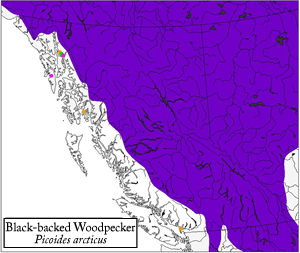Adult male
The entire upperparts, including the back, scapulars, rump, and uppertail coverts are glossy black. The upperwings are also glossy black with extensive, narrow white spots or barring across the primaries (and sometimes partially across the secondaries). The tail is black with unmarked white outer tail feathers.The underparts are whitish with extensive blackish barring across the sides and flanks (most heavily concentrated on the sides of the breast). The head is primarily glossy black, with a sharply contrasting white chin and throat that are separated from the broad white moustachial stripe by a prominent black malar stripe; the white moustachial stripe extends onto the base of the nasal tufts (which are otherwise dusky-black). There is occasionally a small white spot or short stripe behind the eye. The forecrown sports a bold, well-defined, rectangular, bright yellow patch. The iris is dark, the relatively long, straight, sharply-pointed bill is dusky-black, and the legs and feet are dark grey.
Adult female
Very similar to the adult male, but lacks the yellow patch on the crown (crown is entirely glossy black).
Juvenile
This plumage is held into the fall (September) of the first year. This plumage is similar to the adult female, but is duller (less glossy) with a buffy wash on the underparts and more prominent and browner spotting (rather than barring) on the sides and flanks. Juvenile female tend to have the crown entirely black or with a few scattered yellow feathers on the central crown, whereas the juvenile male shows a more extensive and fully-developed yellow patch on the crown.
Measurements
Total Length: 23-25 cm.
Mass: 61-88 g
Source: Pyle (1997); Dixon and Saab (2000)
Picoides arcticus (Swainson, 1832)
Black-Backed Woodpecker
Family: Picidae
Species account author: Jamie Fenneman
Black-Backed Woodpecker
Family: Picidae
Species account author: Jamie Fenneman
Species Information
Biology
|
Habitat
|
Distribution
|
Conservation
|
Taxonomy
|
Status Information
|
BC Ministry of Environment: BC Species and Ecosystems Explorer--the authoritative source for conservation information in British Columbia. |

